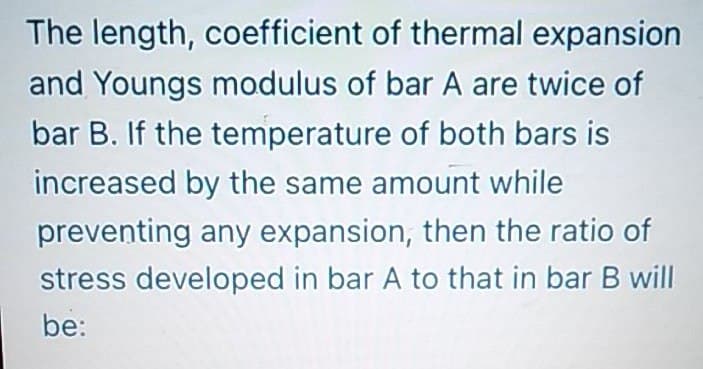The length, coefficient of thermal expansion and Youngs modulus of bar A are twice of bar B. If the temperature of both bars is increased by the same amount while preventing any expansion, then the ratio of stress developed in bar A to that in bar B will be:
The length, coefficient of thermal expansion and Youngs modulus of bar A are twice of bar B. If the temperature of both bars is increased by the same amount while preventing any expansion, then the ratio of stress developed in bar A to that in bar B will be:
Materials Science And Engineering Properties
1st Edition
ISBN:9781111988609
Author:Charles Gilmore
Publisher:Charles Gilmore
Chapter9: Time, Temperature, And Mechanical Properties
Section: Chapter Questions
Problem 2ETSQ
Related questions
Question

Transcribed Image Text:The length, coefficient of thermal expansion
and Youngs modulus of bar A are twice of
bar B. If the temperature of both bars is
increased by the same amount while
preventing any expansion, then the ratio of
stress developed in bar A to that in bar B will
be:
Expert Solution
This question has been solved!
Explore an expertly crafted, step-by-step solution for a thorough understanding of key concepts.
Step by step
Solved in 2 steps with 2 images

Knowledge Booster
Learn more about
Need a deep-dive on the concept behind this application? Look no further. Learn more about this topic, civil-engineering and related others by exploring similar questions and additional content below.Recommended textbooks for you

Materials Science And Engineering Properties
Civil Engineering
ISBN:
9781111988609
Author:
Charles Gilmore
Publisher:
Cengage Learning


Materials Science And Engineering Properties
Civil Engineering
ISBN:
9781111988609
Author:
Charles Gilmore
Publisher:
Cengage Learning
